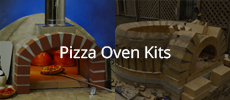Re: Sourdough Starter
Hi Les!
I agree with Faith, there is a lot going on in that bake... Where to start??? Well, a crumb shot would be helpful...
Okay, first a disclaimer, I do not have high altitude baking experience so all comments on such are second hand and ???
First comment is keep feeding your starter. High activity after a week or two is not a guarantee of a robust starter. I know it seems contradictory but young starters often seem to be really active and don't provide much lift and your loaves clearly did not.
I am going to guess you used AP. Per my reading, at elevation one needs to use stronger flour so probably will want to use BF or a blend of BF/AP for your loaves. The dough needs to be stronger because at lower pressure the gases will leak out faster in a weak dough. You probably need to develop the dough more also - longer mixing/kneading than those of us at lower altitudes.
You got some oven spring (particularly on the baguettes) and sticky baskets often diminish loaf volume as is evident on the boules so while I think you are a bit overproofed it is not too bad nor enough to explain the pale look. Given the level of oven spring there should have been enough sugar in the dough to give you a reasonable color.
So, if that is right, the issue is steam. This bake is a great example of why I absolutely detest baking small batches in a WFO. (Now, there are people on this forum who manage somehow to make pretty bread in small batches in a WFO. I am not one of them! Well, I have but not consistently and I haven't worked at it for it is too easy in one of my three kitchen ovens! It is really hard in my experience to get enough steam in the WFO to give a proper and lovely crust if you don't load the oven with bread (say 12-15 pounds or more).
Cloches and cast iron dutch ovens work well because they have only a small volume of air above the loaf. As the water vapor leaves the dough the water vapor drives the air from the container and gives a very high humidity. Let's put this in perspective... A 1.5 pound loaf will lose about 10% of its weight in water while baking. As water vapor that .15 pounds will occupy about 3 cubic feet or almost 22 gallons of air space. That is far greater than the 2 or 3 quarts of empty space in the cloche or dutch oven. OTOH, the volume of your WFO is at least 7 cubic feet. You can't possibly get the oven loaded with steam to the level of the cloche unless you add a LOT of water. So...all in all I think the main problem you had was a dry oven.
WRT hydration, I don't see that as a problem other than sticking. Handling wet dough is a learned skill. If you have problems simply drop the hydration. You can make beautiful bread at 60 percent hydration and the dough will be far more manageable than 70. And you can add hydration as your handling skills improve. A lot of that lies in managing the skin of the loaf. You need enough flour to prevent sticking but as little as possible worked into the dough during forming.
There seem to be some sites that say altitude needs lower hydration. I don't know.
There are also sites that say yeast acts more quickly at elevation... I think that is a misdirection. I suspect it is about the same rate but that the dough will peak earlier because the dough will lose gas faster. Sort of the same effect but a different driver. And that is pertinent because the amount of gas created is a function of sugar consumed which is a function of the total yeast activity and if the gas leaks faster there should be MORE sugar left in the dough when the dough peaks as compared to lower elevations.
Net answer is try it again indoors, probably at a lower hydration, with a bit more mixing, and preferably using a cloche or dutch oven (though a baking stone and good steam generation is an alternative).
One last comment of yours troubles me. You say you heated for several hours but that the oven was "pretty much burned clean" and the hearth was only 750. When I burn my oven clears in 45 minutes or so and if I burn for several hours my hearth will be well over 850 to 900. Your oven may not have been loaded (as Faith and Bill imply). Leaving the door off allows heat to escape through the door and not flow deep into the refractory as you want for baking. You really want to close the oven and let the heat equalize before you load the bread (at least an hour) and then let it cool to a reasonable loading temp of 570 or so. Finding the right timing for all of this is one of the big challenges of WFO baking.
Hang in there!
Jay
Hi Les!
I agree with Faith, there is a lot going on in that bake... Where to start??? Well, a crumb shot would be helpful...
Okay, first a disclaimer, I do not have high altitude baking experience so all comments on such are second hand and ???
First comment is keep feeding your starter. High activity after a week or two is not a guarantee of a robust starter. I know it seems contradictory but young starters often seem to be really active and don't provide much lift and your loaves clearly did not.
I am going to guess you used AP. Per my reading, at elevation one needs to use stronger flour so probably will want to use BF or a blend of BF/AP for your loaves. The dough needs to be stronger because at lower pressure the gases will leak out faster in a weak dough. You probably need to develop the dough more also - longer mixing/kneading than those of us at lower altitudes.
You got some oven spring (particularly on the baguettes) and sticky baskets often diminish loaf volume as is evident on the boules so while I think you are a bit overproofed it is not too bad nor enough to explain the pale look. Given the level of oven spring there should have been enough sugar in the dough to give you a reasonable color.
So, if that is right, the issue is steam. This bake is a great example of why I absolutely detest baking small batches in a WFO. (Now, there are people on this forum who manage somehow to make pretty bread in small batches in a WFO. I am not one of them! Well, I have but not consistently and I haven't worked at it for it is too easy in one of my three kitchen ovens! It is really hard in my experience to get enough steam in the WFO to give a proper and lovely crust if you don't load the oven with bread (say 12-15 pounds or more).
Cloches and cast iron dutch ovens work well because they have only a small volume of air above the loaf. As the water vapor leaves the dough the water vapor drives the air from the container and gives a very high humidity. Let's put this in perspective... A 1.5 pound loaf will lose about 10% of its weight in water while baking. As water vapor that .15 pounds will occupy about 3 cubic feet or almost 22 gallons of air space. That is far greater than the 2 or 3 quarts of empty space in the cloche or dutch oven. OTOH, the volume of your WFO is at least 7 cubic feet. You can't possibly get the oven loaded with steam to the level of the cloche unless you add a LOT of water. So...all in all I think the main problem you had was a dry oven.
WRT hydration, I don't see that as a problem other than sticking. Handling wet dough is a learned skill. If you have problems simply drop the hydration. You can make beautiful bread at 60 percent hydration and the dough will be far more manageable than 70. And you can add hydration as your handling skills improve. A lot of that lies in managing the skin of the loaf. You need enough flour to prevent sticking but as little as possible worked into the dough during forming.
There seem to be some sites that say altitude needs lower hydration. I don't know.
There are also sites that say yeast acts more quickly at elevation... I think that is a misdirection. I suspect it is about the same rate but that the dough will peak earlier because the dough will lose gas faster. Sort of the same effect but a different driver. And that is pertinent because the amount of gas created is a function of sugar consumed which is a function of the total yeast activity and if the gas leaks faster there should be MORE sugar left in the dough when the dough peaks as compared to lower elevations.
Net answer is try it again indoors, probably at a lower hydration, with a bit more mixing, and preferably using a cloche or dutch oven (though a baking stone and good steam generation is an alternative).
One last comment of yours troubles me. You say you heated for several hours but that the oven was "pretty much burned clean" and the hearth was only 750. When I burn my oven clears in 45 minutes or so and if I burn for several hours my hearth will be well over 850 to 900. Your oven may not have been loaded (as Faith and Bill imply). Leaving the door off allows heat to escape through the door and not flow deep into the refractory as you want for baking. You really want to close the oven and let the heat equalize before you load the bread (at least an hour) and then let it cool to a reasonable loading temp of 570 or so. Finding the right timing for all of this is one of the big challenges of WFO baking.
Hang in there!
Jay





 I need to find a solution other than loading the oven with dough because, to be honest, I wouldn't know what the hell to do with all the bread.
I need to find a solution other than loading the oven with dough because, to be honest, I wouldn't know what the hell to do with all the bread.
Comment